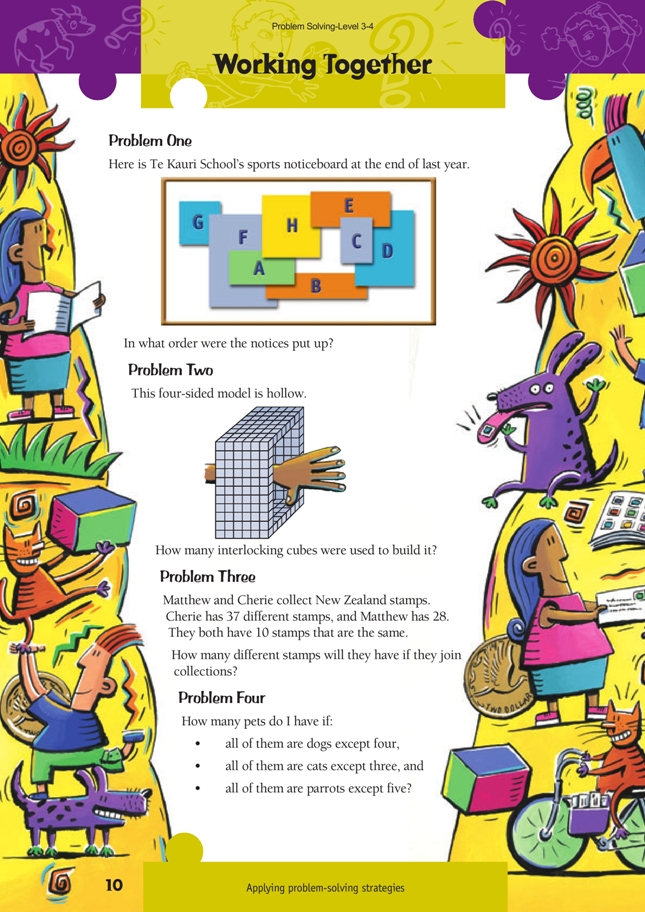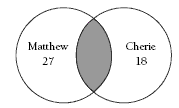These are level 3 number and geometry problems from the Figure It Out series.
A PDF of the student activity is included.
Click on the image to enlarge it. Click again to close. Download PDF (369 KB)
interpret 3 dimensional drawings (Problem 2)
use addition strategies to solve problems (Problem 3)
Problem One
As the students work backwards from the top notice (c), they need to think “What notice can I take off next? What notice has no other notice on top of it?” Answering these questions will give them the order in which they could take the notices off. The notices would have been put up in the reverse order.
Problem Two
There are several ways of solving this problem. The students could find the number of cubes in each side of the model and add them together and then subtract the cubes on the corners that are common to two sides (which can’t be counted twice). Two of the sides are 11 x 6, and the other two are 8 x 6. There are four lots of six cubes on the corners that are common to two sides:
(2 x 11 x 6) + (2 x 8 x 6) – 24 = 132 + 96 – 24
= 204
Another way is to count all the cubes on both sides (2 x 11 x 6) and leave off a row at each end of the top and the bottom (2 x 6 x 6):
(2 x 11 x 6) + (2 x 6 x 6) = 132 + 72
= 204
Yet another way is to calculate how many cubes there would be if the model was solid and then subtract the number of cubes that have been taken out to make the model hollow. The solid model would have 11 x 8 x 6 = 528 cubes. Then calculate the number of cubes to be taken out to leave a hollow shell, one cube thick. The side that is 11 cubes long would need nine cubes taken out to leave one cube at each end. The side that is eight cubes long would need six cubes taken out to leave one at each end. All the cubes in the six-cube width need to be taken out. So the number of
cubes to be taken out is 9 x 6 x 6 = 324. The number of cubes in the hollow model is 528 – 324 = 204.
Extension
Vary the thickness of the shell of the hollow model. The shell is one cube thick in the problem given. Ask the students to find the number of cubes in a hollow model of dimensions 5 x 8 x 9 but with sides that are two cubes thick.
Problem Three
Here are two ways to find the number of different stamps:
• Add Matthew’s 37 stamps and Cherie’s 28 stamps and then subtract the 10 they have in common: 37 + 28 – 10 = 55.
• Matthew has 37 – 10 = 27 stamps that Cherie doesn’t have. Cherie has 28 – 10 = 18 stamps that Matthew doesn’t have. There are the 10 stamps they have in common: 27 + 18 + 10 = 55.
A diagram could look like this:
Problem Four
This problem can be solved using reasoning.
From the first condition, four of the pets are cats and parrots. This means there can be:
• one parrot and three cats or
• two parrots and two cats or
• three parrots and one cat.
Condition two says that three of the pets are parrots and dogs, so this means that you can have:
• one parrot and two dogs or
• two parrots and one dog.
This cancels one of the alternatives in the first condition because you cannot have three parrots.
Condition three shows that five of the pets are cats and dogs. From condition one, you know that you cannot have more than three cats and from condition two, you know that you cannot have more than two dogs. So, to fulfil condition three, there must be three cats and two dogs. Inserting these figures into conditions one and two shows that there must be two dogs, three cats, and one parrot, a total of six pets.
Hints for Students
1. Try working backwards.
2. How many cubes were used to make each side?
Are any of the cubes used for two sides?
You could try a smaller case first.
3. How many stamps have they got altogether? How many stamps have they doubled up on?
4. Can you work out the total number of cats and parrots, the total of dogs and parrots, and the total of cats and dogs? This will help you as you use trial and improvement.
Answers to Problems
1. The three possible solutions are:
G, F, B, A, H, D, E, C
G, F, B, A, D, H, E, C
G, F, B, D, A, H, E, C
2. 204
3. 55
4. Six pets (two dogs, three cats, one parrot)

